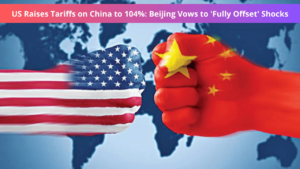The trade tensions between the United States and China have escalated dramatically, with the US Raises Tariffs on China to 104%. In response, Beijing has asserted its readiness to “fully offset” the impacts of these tariffs. This development has significant implications for global trade, economies, and consumers worldwide. Let’s delve into the details, understand the chronology, and explore the potential consequences of this escalating trade war.

I. Background of the Tariff Increase
Chronology of Recent Tariff Escalations
- Initial 34% Tariffs Imposed by the U.S. on Chinese Goods: In early 2025, the U.S. administration imposed a 34% tariff on Chinese imports, citing concerns over trade imbalances and unfair practices.
- China’s Retaliatory 34% Tariffs on American Products: In retaliation, China imposed its own 34% tariffs on American products, matching the U.S. tariffs and signaling its intent to defend its economic interests.
- Subsequent U.S. Tariff Hikes Leading to the Current 104% Rate: The U.S. escalated the situation by adding an additional 50% tariff, bringing the total to 104%. This move was aimed at pressuring China to address longstanding trade issues.
Rationale Behind the U.S. Tariff Policy
- Addressing Trade Imbalances and Protecting Domestic Industries: The U.S. administration’s primary justification for the tariffs is to correct trade imbalances and protect domestic industries from what it perceives as unfair competition.
- Citing National Security and Economic Interests as Justification: Beyond economic reasons, the U.S. has also cited national security concerns, arguing that certain Chinese trade practices pose risks to American interests.
II. China’s Response and Preparedness
Official Statements from Chinese Leadership
- Premier Li Qiang’s Assertion of Ample Policy Tools to Offset External Shocks: Chinese Premier Li Qiang has stated that China possesses sufficient policy tools to “fully offset” any negative external shocks resulting from the U.S. tariffs.
- Commitment to Defending National Interests and Sovereignty: China has expressed a firm commitment to defending its national interests and sovereignty, indicating that it will not yield to external pressures.
Potential Countermeasures by Beijing
- Implementation of Retaliatory Tariffs on U.S. Goods: China has vowed to “fight to the end” and is expected to impose its own set of retaliatory tariffs on U.S. goods.
- Exploration of Alternative Markets and Strengthening Domestic Industries: In response to the tariffs, China may seek to diversify its trade partnerships and bolster its domestic industries to reduce reliance on U.S. markets.Wikipedia
III. Global Economic Implications
Impact on International Markets
- Fluctuations in Global Stock Markets Following Tariff Announcements: The announcement of the tariffs has led to significant volatility in global stock markets, reflecting investor concerns about the escalating trade war. The Economic Times
- Adjustments in Global Supply Chains and Trade Routes: Companies worldwide are reevaluating their supply chains and considering adjustments to mitigate the impact of increased tariffs.
Reactions from Other Nations and Trade Blocs
- Responses from the European Union and Neighboring Countries: Other nations have expressed concern over the escalating trade tensions, with some exploring diplomatic interventions to prevent further escalation. DIE WELT
- Potential for New Trade Alliances and Agreements: The current situation may prompt countries to seek new trade alliances and agreements to safeguard their economic interests.
IV. Effects on Domestic Economies
Consequences for U.S. Businesses and Consumers
- Increased Costs for Imported Goods Leading to Higher Consumer Prices: The tariffs are expected to raise the cost of imported goods, leading to higher prices for consumers on various products.
- Challenges for Manufacturers Relying on Chinese Components: U.S. manufacturers that depend on Chinese components may face increased production costs, potentially impacting their competitiveness. MarketWatch
Impact on Chinese Economy and Industries
- Pressure on Export-Driven Sectors and Potential Slowdown in Economic Growth: The tariffs could exert pressure on China’s export-driven sectors, potentially leading to a slowdown in economic growth.
- Government Initiatives to Stimulate Domestic Consumption and Investment: In response, the Chinese government may implement measures to boost domestic consumption and investment to offset the impact of reduced exports.Wikipedia+4Business News Today+4The Washington Post+4
V. Future Outlook and Possible Scenarios
Prospects for Negotiations and De-escalation
- Potential Avenues for Diplomatic Resolutions and Trade Talks: There remains the possibility of diplomatic negotiations aimed at de-escalating the trade tensions and reaching mutually beneficial agreements.
- Role of International Organizations in Mediating the Dispute: International organizations may play a role in facilitating dialogue and mediating the dispute to prevent further escalation.
Long-term Implications for Global Trade Dynamics
- Shift Towards Protectionism and Its Effect on Globalization: The current trade tensions may signal a shift towards protectionist policies, potentially impacting the trajectory of globalization.
- Emergence of New Economic Power Centers and Trade Partnerships: In the long term, new economic power centers and trade partnerships may emerge as countries adapt to the evolving trade landscape.
US Raises Tariffs on China to 104%: Beijing Vows to ‘Fully Offset’ Shocks
Conclusion
The imposition of a 104% tariff by the U.S. on Chinese imports and Beijing’s vow to “fully offset” the shocks mark a significant escalation in global trade tensions. This development has far-reaching implications for international markets, domestic economies, and consumers worldwide. As the situation unfolds, it is crucial
Also Read :- hindustanhour.com
Pingback: RBI Repo Rate Cut 2025: What It Means for Your Loans, Investments, and Wealth Building - Hindustan Hour